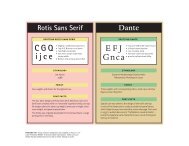Guidelines
Janson Text Pro.
Janson Text Pro.
- No tags were found...
You also want an ePaper? Increase the reach of your titles
YUMPU automatically turns print PDFs into web optimized ePapers that Google loves.
HELVETICA NEUE LIGHT for IBM. Long body copy example.<br />
Size: 10pt<br />
Line Spacing: 15pt<br />
Character Spacing: (0)<br />
Kerning: Metrics<br />
Paragraph Spacing:<br />
2.5mm/7pt<br />
This is just an example to show the look and feel of this font when set<br />
to the above specifications. Water flows through everything—the<br />
air, the land, our own bodies and the global economy. In fact, every<br />
time a good or service is bought or sold, there is a virtual exchange of<br />
water. It takes 700 gallons of water to make a cotton T-shirt, 2,000<br />
gallons to make one gallon of milk, and 39,000 gallons to make a car.<br />
We use water to process raw materials, manufacture products,<br />
generate electricity, and to transport people and goods.<br />
We desalinate it to build cities in the desert. Is it any wonder that in the<br />
last 100 years global water usage has increased at twice the rate of<br />
population growth?<br />
Every time we interact with water, we change its direction, chemistry,<br />
usefulness or availability. Because of this daunting complexity,<br />
water is poorly understood and often mismanaged. For example,<br />
global agriculture wastes an estimated 60% of the 2,500 trillion liters<br />
it uses each year. Municipalities lose as much as 50% of their water<br />
supply through leaky infrastructure. And there are nearly 53,000<br />
different water agencies in the United States alone, each managing a<br />
short stretch of river or a handful of reservoirs.<br />
Amidst this inefficiency, one in five people still lacks access to clean,<br />
safe drinking water, and the United Nations predicts that nearly<br />
half the world’s population will experience critical water shortages by<br />
the year 2080.<br />
But we can do better. Today’s technology can monitor, measure and<br />
analyze entire water ecosystems, from rivers and reservoirs to the<br />
pumps and pipes in our homes. We can give all the organizations,<br />
businesses, communities and nations dependent on a continuing<br />
supply of freshwater—that is, all of us—a single, reliable, up-to-theminute<br />
and actionable view of water use.<br />
Already, we are using sophisticated sensor networks to collect<br />
and analyze the tremendous amounts of data generated in complex<br />
water systems. Together with the Beacon Institute for Rivers and<br />
Estuaries and Clarkson University, IBM is creating a data platform<br />
to support instrumentation of the entire length of the 315-mile<br />
Hudson River for a real-time view of a river system that supplies<br />
both industry and individuals.<br />
In the Netherlands, IBM is working with partners to build smarter<br />
levees that can monitor changing flood conditions and respond<br />
accordingly. And sensors are revolutionizing agriculture, providing<br />
detailed information on air quality, soil moisture content and<br />
temperature to calculate optimal irrigation schedules.<br />
Smart metering can give individuals and businesses timely insight<br />
into their own water use, raising awareness, locating inefficiencies<br />
and decreasing demand. IBM and the Dow Chemical Company,<br />
through its Dow Water Solutions business, are working together to<br />
enable unprecedented visibility into water usage—starting with<br />
desalination plants.<br />
And IBM itself is saving over $3 million a year at one North American<br />
semiconductor plant, through a comprehensive water management<br />
solution. Finally, we can apply advanced computing and analytics<br />
to move beyond “real time” to prediction, supporting better-informed<br />
policy and management decisions.<br />
IBM is involved in a collaborative research initiative with the<br />
Marine Institute in Ireland, which aims to turn Galway Bay into a living<br />
laboratory—instrumenting the bay to gather data on water<br />
temperature, currents, wave strength, salinity and marine life, and<br />
applying algorithms that can forecast everything from wave patterns<br />
over 24 hours to the right time to harvest mussels.<br />
15




